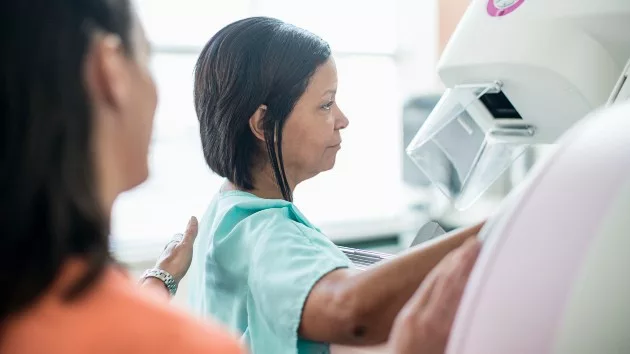(NEW YORK) — Newer three-dimensional imaging is more effective at detecting breast cancer and may improve long-term outcomes, according to a new study led by researchers at the Yale School of Medicine.
The study, which analyzed more than 272,000 breast cancer screenings over 13 years, showed that 3D mammography, known as digital breast tomosynthesis, or DBT, identified breast cancer at higher rates and earlier stages when compared to traditional 2D mammograms.
3D mammography also reduced the number of false positive results, leading to fewer unnecessary tests after initial screening, according to the study, published Tuesday in the medical journal Radiology.
The study builds on a growing body of research suggesting 3D mammography could offer benefits over 2D imaging.
According to lead co-author Dr. Liane Philpotts, this is the first study on 3D mammography of its scale, with 10 years’ worth of 3D screening data.
“It confirms some of what we knew from earlier … and shows the sustainability of these benefits,” Philpotts told ABC News. “But the big take-home point is that the advanced cancer rate was less [with 3D mammography]. That is the most significant finding from this.”
While 2D mammography is still accepted as a gold standard for breast cancer screening, an increasing number of health centers are incorporating this 3D technology.
Here are five questions answered about 3D mammography:
1. What is 3D mammography?
While traditional mammography involves a two-dimensional X-ray image, three-dimensional mammograms use a rotating “X-ray arc” that takes X-rays from multiple angles to create a detailed 3D representation of breast tissue.
This allows radiologists to scroll through 1-millimeter slices to obtain a more comprehensive view of the tissue.
2. Practically speaking, what are the benefits of 3D mammograms compared to 2D, according to the latest research?
3D mammograms may be able to detect breast cancers more frequently and at earlier stages. Earlier detection means earlier treatment and a higher chance of a cure.
In addition, 3D mammograms were associated with fewer false positive results, reducing the burden of unnecessary follow up testing. This could mean less time, money and stress for patients.
“It gives us … a better chance of finding things, and also a reduced chance of having to call people back unnecessarily,” Philpotts said. “So, it’s kind of a win-win from that point of view.”
3. What do current guidelines say about 2D vs. 3D mammograms?
According to the U.S. Preventive Services Task Force guidelines — an influential group of experts whose guidelines help determine government insurance coverage — 2D and 3D mammography are both effective forms of breast cancer screening.
Right now, one is not recommended over the other.
4. Is it covered by insurance?
Many insurance providers, including Medicare, cover 3D mammography.
However, coverage varies depending on insurance company and state of residence, as 3D mammograms are more expensive than 2D.
In some cases, only a portion is covered, or patients must meet a deductible first. Patients may need to call their insurance provider to understand what their individual plan covers.
5. Can I request it during my next screening?
More than likely, if you are due for breast cancer screening, you could receive a 3D mammogram.
3D breast mammography is offered at 90% of certified breast imaging centers. However, 3D imaging may not be necessary for everyone. It is a good idea to speak with your provider about whether it’s right for you.
Copyright © 2024, ABC Audio. All rights reserved.

